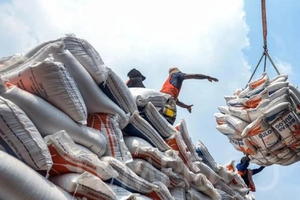Many under-construction property projects have been halted or defered without proper announcement due to the increasing building material prices and the government’s cap on credit squeeze.

Among two main building materials, steel this year rose VND2 million (US$100) per ton year-on-year and the retail price of cement increased VND10,000-20,000 per tons.
Other materials including brick, building sand, crushed rock, paint and furniture also moved up sharply by 10-30 percent.
Nguyen Van Duc, deputy director of property company Dia Oc Dat Lanh, said required investment for a property project increased about 15 percent year-on-year, forcing many investors to halt their projects to reassess the investment.
Pham Huy Nam, investors of an apartment building project in Tu Liem District in Hanoi, said “before starting the project, we expected to sell apartments at the price of around VND4.2 million per square meter. But the increasing material cost pushed up the price to VND5 million per square meter.”
However, raising the retail price is not a appropriate move as the property market is very quiet this year, Nam said.
The construction work on apartment building Hoang Ngan in District 12 in Ho Chi Minh City kicked off at the end of 2010, but it was delayed this year due to the increasing material prices.
Construction site of the Giadinh Plaza project with a total investment of more than VND2 trillion ($100 million) in Phu Nhuan District showcased an abandoned land. The work started on last September.
“Only contractors with strong financial base, who have negotiated with builders to rely on the market prices to assess the cost before starting the construction work, managed to keep their project alive,” said Vu Gia Quynh, vice chairman of the Vietnam Association of Construction Contractors.
Small investors, meanwhile, are struggling with the increasing costs, Quynh told Dau Tu Tai Chinh Newspaper.
Le Chi Hieu, chairman of HCMC-listed construction firm Thuduc House, said many investors had to sell at low prices to recoup some money in order to repay bank loans.
Efforts to overcome the difficult time have seen some property companies put themselves in charge of their project’s construction work.
Nguyen Van Duc, deputy director of the real estate firm Dia Oc Dat Lanh, said the company reduced 10 percent of the total expense of the work on apartment building Thai An 3 by directly handling some parts of the construction.
“2011 is a crucial year for property companies. It will see whether they will survive from difficulties or not. Especially, investors of series of luxury apartment building projects worth around VND30 million ($1,500) per square meter will be under heavy pressures of repaying loans as they grapple to sell the apartments,” said Le Hoang Chau, chairman of the HCMC Real Estate Association.
On March 1, the State Bank of Vietnam ordered all lenders to limit credit to non-production businesses, including real estate projects, at 22 percent of total loans by June 30, and at 16 percent by the end of the year.
The government in February approved a plan to cut annual credit growth to below 20 percent from the initial target of 23 percent as part of a series of measures to curb inflation.
























